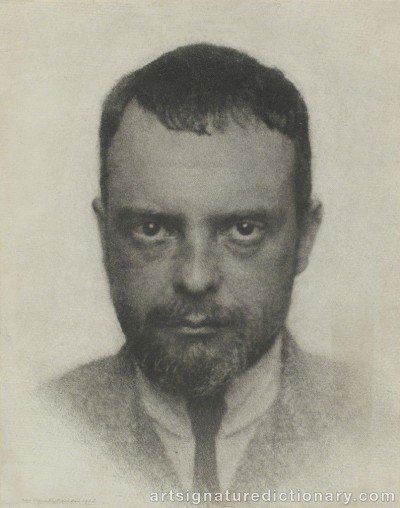
Paul KLEE
1879–1940, Switzerland
Biography
Discover the life and artistic journey of Paul KLEE (born 1879, 18/12, Switzerland, died 1940), including key biographical details that provide essential context for signature authentication and artwork verification. Understanding an artist's background, artistic periods, and career timeline is crucial for distinguishing authentic signatures from forgeries.
Paul Klee wird am 18.12.1879 im schweizerischen Münchenbuchsee bei Bern geboren. 1898 bewirbt er sich an der Münchner Akademie für ein Malerei-Studium, wird jedoch abgelehnt. Daraufhin nimmt er zur Vorbereitung Zeichenunterricht in einer Privaten Zeichenschule, im Jahr 1900 wird er schließlich an der Akademie für die die Klasse von Franz von Stuck zugelassen.
Paul Klee bleibt jedoch nicht lange Akademieschüler und reist 1901 nach Italien, im Mai 1902 kehrt nach Bern zurück und bringt sich autodidaktisch die grafischen Technik der Radierung bei. 1905 reist er nach Paris, der Aufenthalt hinterlässt jedoch wenige Spuren. Den Kontakt zur Avantgarde wird Klee nach einiger, mühseliger Zeit erst in München finden, wo er wieder ab 1906 wohnt.
Durch Galeriebesuche lernt Klee das Werk von Vincent van Gogh und Paul Cézanne kennen. Dies gibt ihm den Auftrieb, sich wieder selbst intensiver mit der Malerei zu beschäftigen. Es entstehen jedoch zunächst vorwiegend grafische Blätter, die in ersten Ausstellungen im Kunstmuseum Bern und im Kunsthaus Zürich gezeigt werden.
1911 lernt Paul Klee in München schließlich Wassily Kandinsky, Gabriele Münter, Franz Marc, August Macke und Marianne von Werefkin kennen. In der Galerie Thannhauser, die die erste Ausstellung des "Blauen Reiters" ausrichtet, sieht Klee auch die Gemälde von Robert Delaunay, die großen Eindruck auf ich machen. Für die zweite Ausstellung des "Blauen Reiters" wird Klee eingeladen, seine grafischen Arbeiten mit auszustellen. 1912 nimmt er an der "Sonderbund"-Ausstellung in Köln teil.
1914 findet die aus künstlerischer Sicht folgenreiche Tunis-Reise statt, die Paul Klee mit August Macke und Louis Moilliet unternimmt. Es entsteht eine Vielzahl von hellen Aquarellen in leuchtenden Farben.
1920 wird Paul Klee von Walter Gropius an die neu gegründete Bauhaus-Schule in Weimar berufen. Hier formuliert er für den Unterricht seine Theorie der "Bildnerischen Formlehre". Während der Bauhaus-Jahre 1920-1931 schafft Paul Klee ein Oeuvre, das sowohl in der Erfindungsgabe von Techniken und Materialien wie auch in der thematischen und bildsprachlichen Vielfalt seinesgleichen sucht.
1931 geht Paul Klee und nimmt dort seine Lehrtätigkeit an der Düsseldorfer Akademie auf. 1933 muss er diese auf Veranlassung des nationalsozialistischen Regimes niederlegen. Er kehrt in die Schweiz zurück.
1935 erkrankt Klee schwer. In den folgenden drei Jahren entstehen nur wenige Werke. Erst 1937 fühlt er sich wieder stark genug und in den wenigen Jahren bis zu seinem Tod entsteht sein bedeutendes und großes Spätwerk.
Paul Klee stirbt am 29.6.1940 in Muralto bei Locarno.
Source: http://www.paul-klee.at/
Paul Klee was born in Münchenbuchsee near Bern on 18 December 1879. In 1898 he decided to move to Munich, where he studied etching and drawing under Heinrich Knirr. Two years later Klee began to study painting at the Munich Art Academy under Franz von Stuck. His first travels took the painter to Rome in 1901/02 and, in 1905, to Paris.
Participating in 1908 in the exhibitions mounted by the Munich and Berlin Secessions, Klee met Wassily Kandinsky, Franz Marc and Hans Arp, who would exert the formative influences on his work. Taking part in the second "Blauer Reiter" exhibition in 1912, Paul Klee met more distinguished contemporaries, such as the artist Alexej von Jawlensky, the poet Rainer Maria Rilke and the writer and composer Herwart Walden. The following year Klee showed work at the First German Herbstsalon. At that time he also did his first watercolours. From 1914 he increasingly devoted himself to working in this medium, most notably during the trip he took to Tunisia with August Macke and Louis René Moilliet.
After a two years' stay there, Klee returned to Germany, where he was invited in 1920 by Walter Gropius to teach at the Bauhaus in Weimar. There he worked at first as a "Formmeister" (Master of Design) and later taught in the free-form painting class. In the years that followed the artist exhibited increasingly both in Germany and abroad: in 1924 he showed work in New York; in 1925 he took part in the first group show of "painture surréaliste" in Paris, where he shared the honours with Max Ernst, Joan Miró, Pablo Picasso et al.
The following year he founded the "blaue Vier" group together with Kandinsky, Lyonel Feininger and Jawlensky. By then Klee was painting chiefly constructive and absolute pictures. Friendship with Kandinsky and his wife as well as trips to Paris, England and Egypt were a welcome change from teaching at the Bauhaus, an activity which came to restrict the artist's creative powers. An appointment as professor at the Düsseldorfer Academy in 1930 released Klee from his contract with the Bauhaus.
Three years later, however, pressure from the National Socialists brought about Klee's dismissal from the Düsseldorf Academy and he moved to Bern. In 1937 the National Socialists removed 102 works by Klee from German museums and that same year 17 of his works were shown at the notorious exhibition of "Degenerate Art". This was the period of the Beam-Stroke pictures and the tragic, demonic figurations which indicate Klee's premonitions of death.
Not long after the Zurich Kunsthaus devoted a one-man retrospective to him, Paul Klee died at Muralto (Ticino) on 29 June 1940.
Source: http://www.paul--klee.com/
Explore other artists
Discover other notable artists who were contemporaries of Paul KLEE. These artists worked during the same period, offering valuable insights into artistic movements, signature styles, and authentication practices. Exploring related artists makes it easier to recognize common characteristics and artistic conventions of their era.